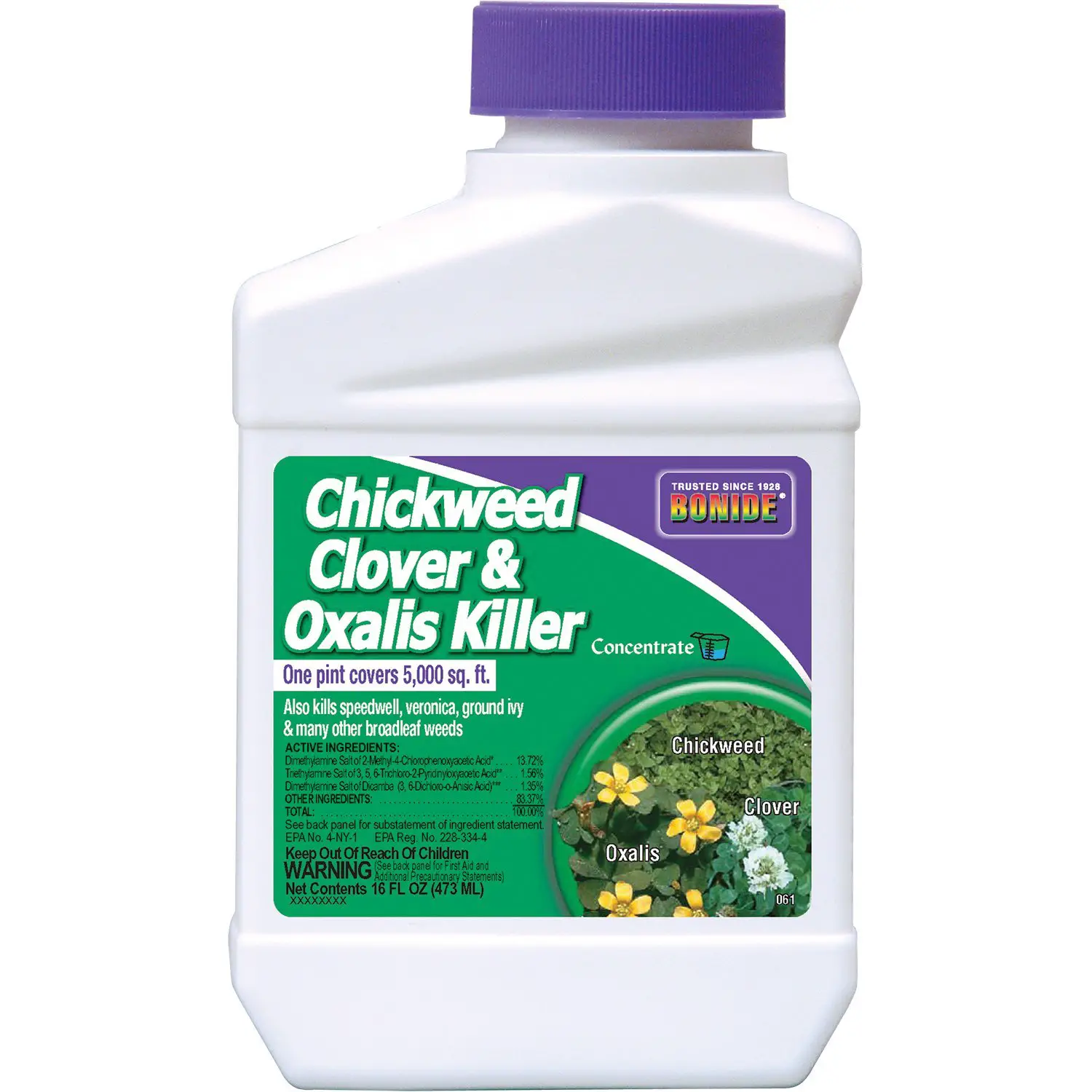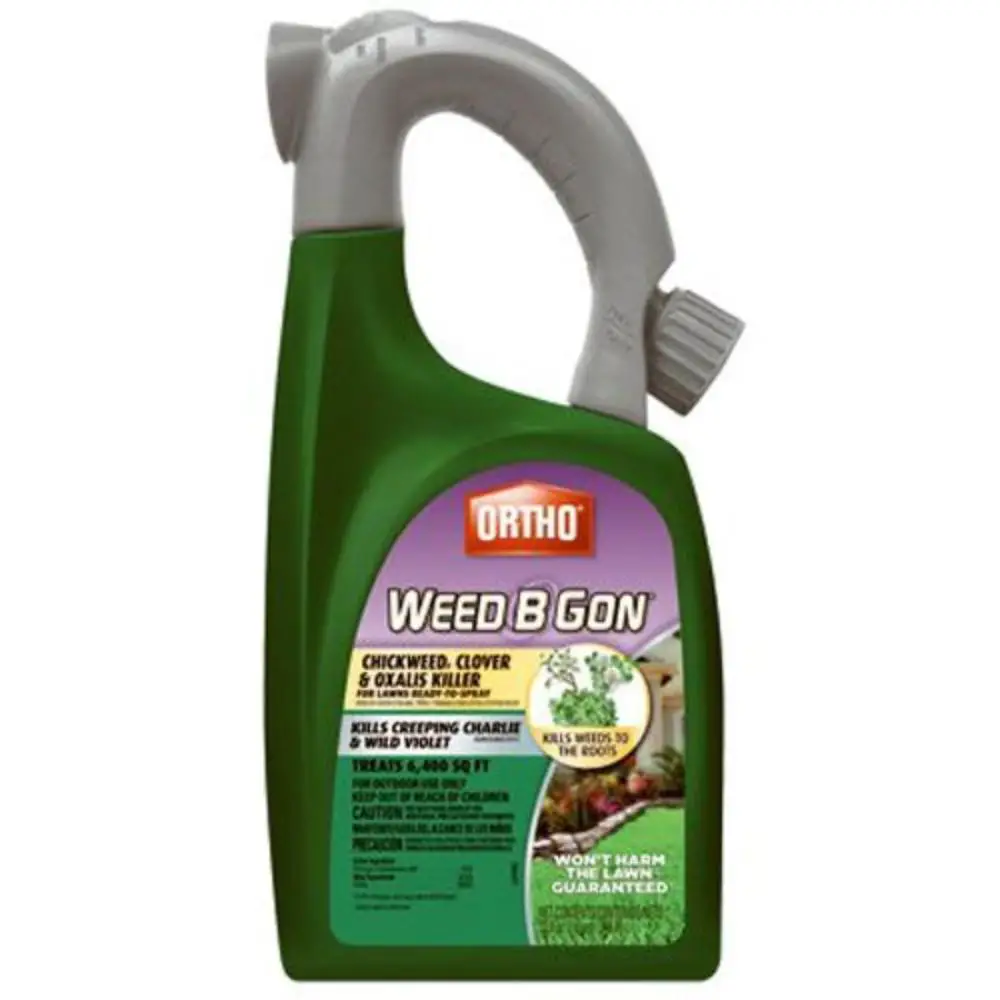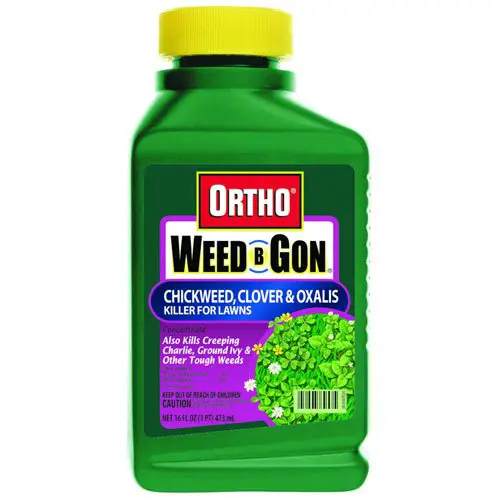How To Identify Clover
Clover is a perennial plant that grows almost everywhere in lawns, alleys, flower beds, and even vegetable gardens. It is quite easy to identify with its leaves which are made up of three leaflets or its small white flowers in round clusters.
White clover is one of the most common weeds in gardens, it can grow in many different places, but it is especially found in sparse lawns where competition from grass is low. White clover grows in a creeping fashion and develops roots where a stem node touches the ground. The flowering period for clover begins in April and ends in September. The fight against clover must be done throughout the year.
Clovers Are Pollinator Friendly
Clover flowers attract pollinators like honey bees. Especially with many pollinators losing their habitats, having a clover lawn can be a safe haven for them. Having honey bees around is good for your garden, honey production, and the environment. Just be careful to avoid bee stings and wasps.
Want an added bonus? Many pollinators are natural pest control, saving you even more hassle and money.
Is Clover A Weed Or Grass
Clover is not closely related to the grass in your yard. It is actually part of the legume family, which means its closest relatives are peas and alfalfa. This is good news because certain chemical control methods that target clover will leave grass unharmed.
Clover is classified as a broadleaf weed, a category that includes other common weeds such as dandelions, poison ivy, and brambles. This is important because herbicides and methods for broadleaf weed control are effective ways to kill clover.
Also Check: How To Get Rid Of Moles In Your Lawn Naturally
Don’t Miss: Why Should I Aerate My Lawn
Best Post Emergent Herbicides
Post-emergent herbicides are the best way to kill clover. Just keep in mind they require a little patience since it could take a couple weeks for the clover to die back. Also, repeat applications will likely be necessary, and mixing in a little surfactant with the herbicide will help the herbicide stick to the plant. Also, notice that there are different recommendations for cool season grasses vs warm season grasses.
Dont Miss: How To Take Out Grass From Lawn
A Useful Past And Fun Facts

- Clovers specifically Trifolium repens have for centuries been domesticated ground cover plants or livestock forage plants.
- Clover is a legume, in the same plant family as peas, beans, and peanuts.
- While it is native to the Mediterranean, it was introduced into the United States early in the colonial days.
- Today, it grows readily from Canada to Texas, from Florida to Alaska.
Recommended Reading: How Much Do You Pay For Lawn Mowing
Why Kill Clover In Your Lawn
Coupled with quackgrass, crabgrass, and dandelions, clover rounds out the most common lawn weeds list. If you dont want it in your landscape, its imperative to get rid of it immediately because it is considered highly invasive. It has an aggressive spreading habit that allows a single plant to multiply in size and take over your yard and flower beds quickly.
Use A Natural Weed Killer
Perhaps the most popular natural weed killer, vinegar is a great option to try if youre wondering how to get rid of clover. Mix a solution of one part water, one part vinegar and a couple drops of dish soap, add it to a spray bottle, then douse the clover. It may take a few weeks of frequent applications, but this natural blend wont harm grass or other plants, and is safe for use around kids and pets, too.
Once the solution has done its job, youll want to put grass seed down in any empty spots where there used to be clover in your lawn.
Read Also: Where Can I Trade In My Lawn Mower
Getting Rid Of Clover In Your Lawn
October 25, 2018// by Scott Smith
White clover is a very easy weed to recognise, and you may have spent countless childhood hours hunting for the four-leaf version. While that can be a fun challenge, eradicating a clover infestation from your lawn is not.
A common weed in Australia, clover has the very recognisable three green serrated leaves topped by white, ball-shaped flowers and creeping stems. Clover is a legume plant that draws nitrogen from the air to store in its roots. It spreads easily throughout lawns via stems attached to the soil which grow into new plants. Clover is a winter-germinating weed, and will thrive and spread in spring when soil temperatures are mild and warm and plenty of sunlight reaches the soil surface.
Clover can often be quite difficult to get rid of, as it reseeds itself every year and will continue to come back. It spreads easily in a few different ways, and can even propagate from its own clippings.
How Do I Identify Clovers In My Yard
Clover is a legume that made its way to North America in the latter part of the 17th century, and its origins can be traced back to Europe. Edenapp brings the three most common types of clover and their distinguishing characteristics to help you identify them.
- White clover : White clover is the most common clover species found in lawns. It is a perennial, low growing and hardy clover species that spreads really quickly through stolons. You can identify it by its distinguishing characteristics, which are the florets that grow on its ends in shades of white and pink.
- Red clover : Red clover can thrive in both dry or moist conditions. This type is bushier and taller than white clover, and you can identify rec clover by the florets, whose color ranges from red to magenta. Red clover is also called meadow clover, wild clover and cow clover.
- Strawberry clover : The growing patterns of strawberry clover are similar to white clover, the difference being that strawberry clover can thrive in coastal areas or near river estuaries as it has a higher salinity tolerance. You can identify strawberry clover by its pink and white florets that are smaller than those of white clover.
You May Like: Do It Yourself Lawn Mower Repair
How To Get Rid Of Clover In Your Lawn
When Clover begins taking over lawns it tells us something very important about our lawn health, and most importantly about the health of our soils.
Also when we begin seeing Clover in lawns, we often see that our lawns themselves may also be turning brown or yellow in colour, as well as possibly having slowed growth and looking generally in poor overall health.
You Should Smother It
Clover can survive just fine when grown away from other plants, particularly large grasses like the common lawn variety.
Lawn turfgrass will die if you try to smother it with a plastic sheet, but in most cases, it grows back quickly and is little more than a minor inconvenience.
Clover planted near trees or shrubs will also grow even outside of the typical lawn environment as long as growing conditions are good and too much moisture isnt present because clover does not tolerate waterlogged soils.
You May Like: How To Replace Lawn With Clover
How To Identify Clover In Your Yard
There are three types of clover that are most commonly found in lawns: white clover, red clover, and microclover. White and red clover are easily identified by their sphere-shaped clusters of tiny blooms and trio of petal-shaped leaves, each leaf bearing a white crescent or a V shape and measuring approximately one-half inch in size. The clover plant normally grows to no more than four to six inches in height although it can reach as much as 12 inches in height.
White clover can be found blooming from early spring until late fall. Red clover begins to bloom in late March and continues into April and can continue to bloom into early summer. Microclover is identified by leaves that are approximately half the size of white and red clover leaves. Once microclover has been mowed it may grow back at only one-third its original size. Microclover has significantly fewer flowers than red or white clover and its growth is denser and more far-reaching than the red or white varieties.
Microclover looks more uniform than other varieties of clover found in lawns, especially after its flowers have been removed by mowing. It grows lower to the ground than its counterparts. The fact that all varieties of this plant tend to grow close together makes it easy to spot clover patches in your yard.
Getting Rid Of Clover In Lawn Naturally

What kills grass and weeds permanently? The most natural way to control clover is by removing it manually. As soon as you spot a clump of the three-leaf weed, pull it out, root and all.
To remove, loosen up the soil at the base and gently pull the clump out of the ground. Repeat until you successfully remove all clover plants from your lawn.
This is actually the best way to get rid of clover, crabgrass, and almost every other type of weed or grass that grows where it shouldnt. It does take a little time but the reward is knowing that the weeds wont pop up again.
Of course, if you try to kill poison ivy by pulling it by hand, it is very important to wear protective clothing to keep from getting the urushiol on your skin. Thick gloves, long sleeves, and long pants are a must.
Also Check: How To Mow Peoples Lawns For Money
Spread Mulch Where Clover Has Taken Root
It may be tough to make sure youve got all the roots if the clover has sunk its root tendrils into your flower beds or the space around your trees. If you leave even one living root, you may see your clover return before long.
A simple solution is to lay down a piece of landscape fabric and dump a heavy supply of mulch on it. The mulch will nourish the soil around your flowers or trees, and the fabric will help prevent clover growth.
Spread Organic Fertilizer To Kill Clover
If there are small patches of clover in your lawn then a good way to get rid of them will be to use nitrogen rich organic fertilizer instead of using chemical fertilizer. These fertilizers are slow release fertilizers and will slowly kill off the clover due to nitrogen overdose.
The benefit of using organic nitrogen rich fertilizers is that they dont harm your landscape in any way and they encourage healthy lawn growth in the long run but the downside is that they act slowly. Therefore they can only be used when the weed coverage is small enough that you can afford to wait for the organic fertilizer to do its job.
Recommended Reading: How To Plant Grass On Existing Lawn
Should I Get Rid Of Clover In My Lawn
There are several reasons you may want to keep clover in your lawn. Due to its symbiotic relationship with bacteria, clover acts as a natural fertilizer. Clover gets its nitrogen from the air and releases it into the soil. Another benefit? Clover outcompetes other weeds. So instead of something unwanted and unsightly, you could have clover.
How To Kill Clover In Lawn Without Killing Grass
- How To Kill Clover In Lawn Without Killing Grass
Use the weed control that the professional do b. If you dont want to pull clover by hand, you need an effective weed killer that wont harm your grass.
How To Get Rid Of Clover Naturally How To Get Rid Lawn Care Tips Clover Lawn
Please enable JavaScript
Also Check: What To Put On Lawn To Kill Ants
Read Also: Does Ace Hardware Rent Lawn Mowers
Make Your Own Clover Killer
Its easier than you may have thought to get rid of clover in flower beds or spots in your lawn. We have a variety of simple methods and homemade recipes that show you how to get rid of clover and prevent it from coming back.
Well show you how to make a natural acetic acid weed killer spray and how to perform weed control by maintaining a healthy lawn. Visit your pantry and the cabinet beneath the kitchen sink for the ingredients for this simple weed killer.
Planting And Maintaining A Clover Lawn
- Clover lawns can be established by encouraging already-existing clover patches in your landscape, by seeding, or a combination of both.
- It is best seeded in early spring from mid-March to mid-April. It can also be seeded in fall. Tiny clover seeds are difficult to sow evenlyone way to improve your chances is to mix the seed in with some soil, sawdust, or sand. If you donât have any in your lawn or nearby, you may need to add a bacterial inoculant to promote the best growth if you do already have it in your lawn, however, the inoculant is probably already present in the soil.
- After planting, use a misting attachment to water daily until you can see the seedlings.
- Existing clover patches can be encouraged by mowing with the blades set at 1.52 inches, which favors clover over most traditional turf grasses.
- In the middle of summer, stop mowing to encourage clover to flower and seed.
- Once established, most clovers are low-growing and require little or no mowing, unless you wish to discourage bees by mowing to prevent summer blooms.
- Never apply herbicides to a clover lawn.
- It is a short-lived perennial and may require reseeding approximately once every three years to maintain consistent coverage. It may successfully reseed naturally, however, or wild clovers may move in and take over aging stands.
Recommended Reading: Where To Dispose Lawn Mower
Clovers Fertilize Your Lawn
If youre tired of spending loads of cash on nitrogen for your lawn, let clover do the job for you. According to Melissa Sharapova, a permaculture and landscaping expert, Clovers are a beneficial addition to turfgrass because they fix atmospheric nitrogen into soil eliminate the need for synthetic fertilizer.
There are also ecological benefits to reducing your synthetic fertilizer use. A 25 years veteran in the horticultural industry, Sharapova adds that less fertilizer use reduces nutrient runoff into local streams and aquatic habitat.
Plant Seeds In The Bare Areas

There might be bald spots on your lawn that are even less appealing than the weeds themselves after successfully eliminating clover patches.
To solve this problem, it would be best to immediately spread grass seeds on those bare spots and cover them with an adequate amount of mulch. In addition, to prevent clover from coming back, we suggest you water the grass seeds consistently. And use correct lawn care practices such as fertilization and mowing.
You May Like: How To Find Lawn Mowing Service
The Benefits Of Clover In Your Lawn
It might seem like an odd subheading in an article about eradicating clover but stick with me here.
Nonetheless, were all about picture-perfect lawns here at MOOWY. And the presence of clover can indicate problems with your garden soil that are weakening your grass plants.
And for this reason, clover is often referred to as a pointer plant.
How To Kill Clover Using Herbicides
Some homeowners opt to use chemical herbicides to kill actively growing weeds or prevent clover from growing. Chemical control methods can be a very effective weed killer when used properly, so it warrants talking about them quickly.
There are two different approaches to killing clover, differing in timing.
You May Like: Where Is Lake Lawn Resort
S To Getting Rid Of Clover Manually
If you want to manually remove clover from your yard permanently, it will be necessary for you to remove the entire root system of the weed as well as the weed itself. You can do this with a spade or with your hands. Carefully loosen the soil all around the plant, and then pull the plant, along with its roots, out of the ground. You will want to make sure you get all the roots otherwise, the plant will just grow back. While this root removal can be a tedious and time-consuming task, when done correctly, it is a surefire way to reduce clover once and for all.
Another way to manually remove clover is to kill it by cutting off its access to sunlight and air. This could be done by covering the clover patch with a dark-colored trash bag or another type of plastic sheeting. Secure its edges to keep it in place. Make sure you havent covered any of your grass in the process, or it will be damaged or killed as well. In a few weeks, your clover problem will be solved.
You can also use a DIY mixture to spot treat the clumps of clover in your yard. Combine vinegar with a little dish soap and pour the concoction into a spray bottle. Spray directly onto the clover. Again, you will want to take care not to involve nearby grass or other plants in this treatment, or they will be destroyed along with the clover.